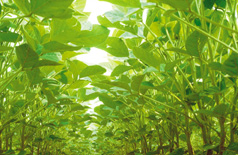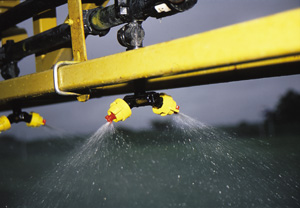
Features
Agronomy
Identity Preserved
Sprayer technology tune-up
How it is used is most important.
March 10, 2008 By Ralph Pearce
The advent of newer sprayers, nozzles and chemistries in the past decade has had a curious impact on growers and their understanding of sprayer efficiency and product efficacy. Despite higher commodity prices and the prevalence of advanced genetic traits, the fundamentals of spraying have never been more important. The intricacies of sprayer technology, nozzle designs, water volumes and pressures, droplet physics, boom height and how they affect optimum product performance is complex enough. Yet growers can become too focussed on outdated standards on spray pressures or get bogged down in the overwhelming choices of nozzle designs and types, often leading to less-than-ideal performance in the field.
 |
| Canopy penetration can be affected by a number of factors, including nozzle design, pressure and speed of the applicator. |
For Dr. Tom Wolf, a research scientist with Agriculture and Agri-Food Canada’s Saskatoon Research Centre, the simple take-home message on sprayer technology is that what a grower has is not as important as how it is used. It is not necessary to buy the latest nozzle designs to maximize the performance and efficiency of the sprayer. “With our trials, we discover that there’s a fair bit of new learning that has to accompany the use of a new nozzle,” says Wolf. “A new nozzle by itself doesn’t solve your problems for you, it creates new ones, actually.”
What has driven this shift, notes Wolf, is a combination of a number of factors. On one hand, there was the arrival of a relatively new class of low drift nozzles in the past 10 years, along with the use of high clearance sprayers and their capacity to change speeds quickly resulting in pressure changes at the nozzle through rate controllers. On the other hand, there has been a heightened awareness of the societal shift towards environmental stewardship in Canadian society. “With that was the change in regulatory structure within the Government of Canada, where they went from having pesticide regulations led by Agriculture and Agri-Food Canada to having it lead by Health Canada,”explains Wolf. That placed a new emphasis on a greater willingness to regulate. “Finally, we started to see genetically modified crops for herbicide tolerance, where the herbicides used in those crops were not selective by nature, or had a very broad spectrum. We never used to spray glyphosate in the middle of the growing season, it was always before seeding or after harvest, when off target impacts were not as likely. Now, we spray them when everything is growing vigorously and green.”
Other factors affecting sprayer technology use and adoption include price volatility and in eastern Canada, a shift in diseases and pests now confronting soybean growers. Growers now can look forward to having to deal with a mix of soybean aphids, bean leaf beetles, soybean cyst nematode, phytophthora root rot, fusarium and now Asian soybean rust, all on a more frequent basis.
The one thing to remember from Wolf’s perspective is that there are really only four types of nozzles: Conventional flat fan, pre-orifice, low pressure air-induced and high pressure air induced. The manufacturers may insist there are differences in their designs but Wolf tests their performance upon release, determining which of the four it represents.
Of fundamentals and revelations
All of these factors present a greater argument for understanding the basics of spraying technology, and that goes beyond the specifications of the sprayer or the nozzles. It also includes water volumes, pressures, boom height and the product being applied (fungicide and insecticide versus herbicide). “One thing about low drift nozzles is aside from being a way to reduce environmental impact, they’re also an agronomic tool,” says Wolf, noting the advantage of having a positive outlook. “Because of their ability to minimize drift even under windy conditions, these nozzles let you be timely when previously you couldn’t be. A fungicide applied well at the wrong time is not very valuable compared to a fungicide applied at the right time even if the application isn’t 100 percent.”
As more research is done, more is understood about spray patterns and boom height, water pressures and volumes. Droplet sizes and the physics of how they shatter on contact and the coverage that results is one factor that has come out of more research. Although the mechanism of how air-induced sprays maintain good coverage is not well understood, we've been successful in pushing the envelope toward practical goals, like using as little water and causing as little drift as possible while maintaining coverage and efficacy.
Wolf also concedes that improved technology has shown that as specific as a grower could get with nozzles and water volumes, speed and boom height, time and physical constraints simply do not allow growers to be that precise. “Every single situation is a special case, and are we prepared to make an adjustment for every single situation?” poses Wolf. “The short answer is that we can’t afford to.”
The example Wolf cites is using a fungicide. To protect the plant, the active ingredient has to cover the plant. But the plant is not the same all over: there are flat leaves, leaves that point up, there are stems and petioles, there is the underside of the leaf, the top of canopy and the bottom of the canopy. And some pathogens are more aggressive on stems than leaves. One spray solution is not likely to cover all those bases. “It’s the same thing with insecticides, where some of them are systemic requiring the insects to consume plant material to acquire the dose while others are contact,” says Wolf, adding that insect location is also very important. “Very quickly, you realize there’s no way someone can communicate this complexity with enough recommendations for the farmer. At some point, we’re going to have to say, ‘This is the way I think you should spray in general, and when you get into this situation, make ‘this’ adjustment in water volume or rate pressure to optimize that’. I’d rather do that than over-complicate things and say, ‘Buy these 10 nozzles and change them every time your field changes’.”
Old habits may be hard to change
Helmut Spieser understands all of what Wolf is trying to convey to growers; he has been saying much the same thing for years: the technology is good and it is readily available, but it is how it is used that is the key. “We tend to think, ‘I’m not getting really good weed control, therefore I need a new sprayer’, and it’s a way of justifying it,” says Spieser, engineer specializing in field crop conditioning and the environment, with the Ontario Ministry of Agriculture, Food and Rural Affairs. “I tell growers that a brand new rig hooked on behind does not a good job make. It’s the person in the seat and the decisions, and the when and how and what product they use that really dictates the success.”
 |
| The bottom line on nozzle designs: it is not whether it is the latest but how a grower uses it that is the most important factor. |
Part of the challenge Spieser has found from past presentations is that what was said years ago comes back to haunt them, as growers readily commit their recommendations to memory. “Once upon a time, we said anything more than 40psi is just silly if we’re spraying weeds,” details Spieser. “Now, the new nozzle technology allows you to go higher, yet still result in much less spray drift but the farmers still remember the 40 pounds of pressure, and they’re often reluctant to change. They like it but they don’t understand that with air induction nozzles, they can run boom pressures of 80psi yet the working pressure at the exit orifice is likely still around 40psi or less.”
Yet growers are stressed for time to the point where they might argue they cannot afford to immerse themselves in the science of something like droplet technology. The only counter to that for Spieser is that without the right information, the likelihood of doing the wrong job increases. “If a grower chooses a brand of nozzle that requires higher pressures and runs it at 40 pounds pressure, they’ll end up with less than acceptable weed control,” he says. “It’s not the fault of the nozzle, it’s not the fault of the product, it’s really an error in setting it up and where it was operated in terms of pressure.”
Companies helping out
The best part of the change in technology is that the companies have been doing their best to help. As more information becomes available, not just about the specifications of their nozzles but about droplet physics and matching pressures with volumes and products, the companies are incorporating more into their catalogues. “The nozzle manufacturers have made a major shift in putting a lot more detailed droplet size information into their catalogues and that’s excellent,” says Spieser. “But growers have to go there, and normally if a new catalogue comes out, they’re into what’s new, what sizes and colours are there, but the technical information is in the back of the book, and I suspect not many of them venture to that section.”
The only issue Spieser has with the companies releasing so many new designs is that they may not be doing growers any favours. “Now, instead of 20 choices to get the job done, we may have 24,” he says. “If you have a choice of two, sometimes that’s enough, otherwise it can become a little overwhelming. -end-
As a quick aid in nozzle selection, Helmut Spieser of the Ontario Ministry of Agriculture, Food and Rural Affairs offers this list of dos and don’ts when in the market.
Do:
• Choose water volume based on product performance, not acres per tankful.
• Calculate nozzle size required based on travel speed, nozzle spacing and application rate.
• Determine droplet sizes required to apply the spray product.
• Learn new droplet classification system adopted by all nozzle manufacturers (very fine, fine, medium, coarse, very coarse, extremely coarse).
• Operate nozzles at a pressure to produce the required droplet size.
• Understand the environmental influences on droplets travelling from the nozzle to the target.
• Maintain adequate nozzle-to-target distance to allow full spray pattern development.
• Calibrate routinely to know your precise application rate.
Don’t:
• Choose a nozzle type without considering drift consequences.
• Buy nozzles based only on price. -end-